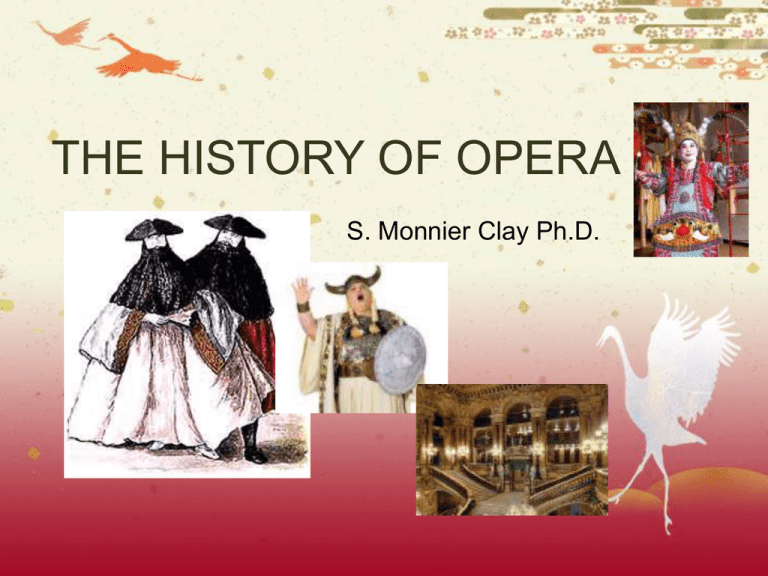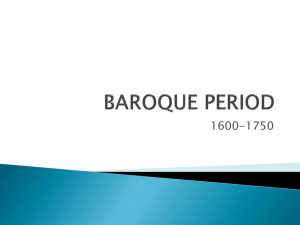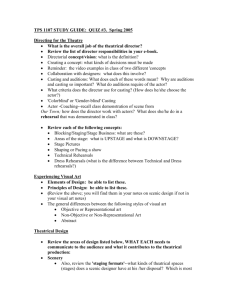Opera - France with Simone
advertisement

THE HISTORY OF OPERA S. Monnier Clay Ph.D. Opera In Italian opera means “work”, and refers to a musical drama in which singers convey the drama. An opera unites all art forms: -literature; -singing; -acting; -sometimes dance (especially in French operas) -costumes; -musical instruments, -scenery -staging. The origins of opera The history of opera can be traced back to ancient Greece where people would perform musical dramas with an occasional song from the choir to further the plot. Using recitatives, the Italian, Jacopo Peri (1561-1633), created the very first Italian opera, Dafne, which debuted in 1594. Later, Peri wrote a piece of music for the comedy La pellegrina that was performed at the wedding of the Grand Duke Ferdinando and Christine of Lorraine. This music is called an intermedi, which is a musical interlude performed between acts in a play. The golden age of baroque opera during the XVIIth century The first great composer of operas was Claudio Monteverdi (1567-1643) who produced opera’s first masterpiece, L’Orfeo, which premiered in Mantua, Italy in 1607. Opera soon spread from Venice and Rome throughout Italy and the rest of Europe with Lully in France, Schütz in Germany and Purcell in England, all helped to establish their national traditions during the 17th century. In Italy, two parallel genres of opera develop simultaneously: -The opera seria (serious opera) in opposition to -The opera buffa (of popular origins). In France, the history of opera begins with a play that incorporated a number of songs, Le jeu de Robin et Marion by Adam de la Halle and performed in 1275. This play is considered to be one of the first operas because it combined dialogues - either spoken or sung. However, the songs were of popular origins, and were not new compositions. The French Ballet de Cour As in Italy, the 16th century in France had its form of entertainment mixing theatrics, voices and instruments. It was known as the ballet de cour, and its first known example was the Ballet de la Royne by Joyeuse (1581). Since then, in France, ballet is included in the staging of an opera. Performance of Alceste in Versailles (1674) Lully and French opera -Lully (1632-1687) came to France under Louis XIV and started to write ballets for the king, who loved to dance. In one especially famous ballet the king danced the role of Apollo, the Sun-God, whence the image of the Sun-King. -In 1664, Lully (1632-1687) worked on 13 comédies-ballets with the playwright Molière (La Princesse d’Élide; Le Mariage forcé, 1664; L'Amour médecin, 1665; Georges Dandin, 1668; Monsieur de Pourceaugnac, 1669; Le Bourgeois gentilhomme, 1670; Psyché, 1671). At times, both clashed on matters of pronunciation and how to set the French language to music, Jean-Baptiste Lully and their collaboration ended in 1671. -After Molière's death (1673), Lully moved to create the French answer to the Italian opera seria, but it was more of a sung tragedy than an opera, the first ot these works was Cadmus, performed in 1673. -The 17th century was also the high point of French tragedy, as served by Corneille and Racine. Lully extended this genre of tragedy into music, hence the generic names of French opera seria became tragédies en musique or tragédies lyriques. -Lully's operas were to profoundly shape the history of French opera, down to the late 19th century. -Among the main characteristics were: an orchestral accompaniment, the inclusion of danced interludes, a standard structure of a Prologue followed by 5 acts, frequent dramatic and musical use of the chorus, libretti written in refined verse, subjects drawn from classical mythology. Most of these characteristics persisted down to Verdi. The librettist Lully’s first tragédie lyrique Cadmus et Hermione was performed on the 27th of April 1673 on a libretto written by Philippe Quinault (1635-1388) who became his librettist life-long librettist and the first of the great opera librettists. Philippe Quinault Under the Sun King (Louis XIV), Lully controled musical life in Paris and Versailles. He had a great influence on European music of his time and he inspired many composers such as Henry Purcell, Georg Friedrich Haendel, Johann Sebastian Bach, and Jean-Philippe Rameau. Lully's operas were written mainly for the king in Versailles, but they were immediately performed in Paris as well, in the newly created Académie Royale de Musique or Paris opera. The greatest epigone of Lully was André Campra (1660-1744), whose style is close to that of the master, but who showed more invention in particular in the choral writing. Tancrède was quite successful, and performed until 1764. (The title-role was created, and sung for 30 years, by Thévenard.) André Campra (right), librettist Antoine Danchet (centre), and artist Bon Boullogne (left). Marc-Antoine Charpentier (164-1704) was more influenced by Italian opera, and was not in favor with Lully, who possibly detected a serious rival. Charpentier's friendship with the king's nephew (Philippe d'Orléans, future Regent) got him a shot at the Paris opera in the form of Médée. Baroque opera: Cecilia Bartoli in Händel's Lascia la Spina http://www.youtube.com/watch?v=0qv88wKEA5M&feature=related The French opéra-comique The French opéra-comique was born on the 14th of May 1697. On that day, Louis XIV, pressured by French playwrights, ordered the closure of the Italian Theatre in Paris. When the Italian theatre closed, the people running various fairs around Paris quickly organized spectacles meant to replace those offered by the Italians. -At that time, there were six fairs around Paris, and two of them were extremely popular: The Foire Saint Germain (open between February and April) and the Foire Saint Laurent (open from the end of July until the end of September.) These fairs gave birth to a type of entertainment full of vitality with plays where singing alternated with spoken dialogues. Eventually, an opera house was opened for their performance. The Foire Saint-Laurent Paris, the Opéra-Comique The Opéra-Comique Opera in England In England, one of opera's antecedents in the 16th century was an afterpiece which came at the end of a play; often scandalous and consisting in the main of dialogue set to music arranged from popular tunes. In this respect such afterpieces anticipate the ballad operas of the 18th century. At the same time, the French masque was gaining a firm hold at the English Court, with lavish splendor and highly realistic scenery. Inigo Jones became the leading designer of these productions, and this style was to dominate the English stage for three centuries. These masques contained songs and dances. In Ben Jonson's Lovers Made Men (1617), "the whole masque was sung after the Italian manner, stilo recitativo. Purcell and his contemporaries The approach of the English Commonwealth closed theatres and halted any developments that may have led to the establishment of English opera. However, in 1656, the dramatist Sir William Davenant produced The Siege of Rhodes. Since his theatre was not licensed to produce drama, he asked several of the leading composers (Henry Lawes, Cooke, Locke, Coleman and Hudson) to set sections of it to music. This success was followed by The Cruelty of the Spaniards in Peru (1658) and The History of Sir Francis Drake (1659). These pieces were encouraged by Oliver Cromwell because they were critical of Spain. With the English Restoration, foreign (especially French) musicians were welcomed back. In 1673, Thomas Shadwell introduced Psyche, patterned on the 1671 'comédie-ballet’ Psyche produced by Molière and Lully. William Davenant introduced The Tempest in the same year, which was the first Shakespeare play to be set to music (composed by Locke and Johnson). Late Baroque opera The next big figure after Lully was Jean-Philippe Rameau (1683-1764). The first opera was Hippolyte et Aricie (1733), the libretto inspired by Racine's play Phèdre. The novelty of Rameau's music, especially in the orchestral accompaniment and the density of musical material, sparked furious controversy between Lullists and Ramists; but within a few years Rameau had come to dominate the the stage, and remained the pre-eminent composer of operas to his death in 1764. Jean-Philippe Rameau Rameau contributed to: tragédies lyriques (Castor et Pollux 1737, Dardanus 1739, Zoroastre 1749, les Boréades 1764) and opéras-ballets (Platée, Pygmalion, les Surprises de l'amour, les Indes galantes, Anacréon, les Boréades). The Querelle des Bouffons In the early 1750s, an extraordinary controversy, called the Querelle des Bouffons, raged amidst the Paris intelligentsia. In 1752, the Paris opera's management decided to invite a company of Italian singers for a year-long residence, to perform Italian buffas, including Pergolese's Serva Padrona. To many, the Italian music seemed so airy, so light in contrast to the intellectual complexity of the tragédie en musique. The philosopher Jean-Jacques Rousseau, himself a composer, and the author of most of the music entries in the Encyclopédie, led the camp of the pro-Italians. He and Rameau were already engaged in a rather bitter controversy over those articles, some of which attacked Rameau's treatise on harmony (Rameau was a proponent of equal temperament, which Rousseau claimed was a mathematician's delight but a musician's nightmare). The controversy was furious. In order to appease the opponents, the government commissioned Jean-Joseph Cassanéa de Mondonville (1711-72) to write an opera which could serve as rallying point. This he did with Titon et l'Aurore. It won the day, in particular because Louis XV sent soldiers to take over the pit held by the pro-Italian subscribers; during the night of the creation, reports of the battle were sent every 15mn to Versailles. The battle was won by the French side, although the “war” raged for months. In the end, the pro-French party won and Italian music was expelled from the Opera. The Eighteenth Century During the 18th century, Italian opera dominated most of Europe, except France, attracting foreign composers such as Handel. After Lully and Rameau, the next big event in Paris was Glück (1714-1773), who wrote for the Paris opera in the tradition of the tragédie lyrique. His operas were performed into the 1820s, alongside those of Piccinni, Sacchini and Grétry, Paisiello and Spontini (1800s), until Rossini came along. Maria Callas.- "J'ai perdu mon Eurydice” http://www.youtube.com/watch?v=PF5FhF_t5i4&feature=related Milan, Italy the Scala built in 1778 The Classic opera (from c. 1750 to c. 1820) The most influential figure of late 18th century opera was Mozart, (1756-1791) who began with opera seria but is most famous for his Italian comic operas, especially The Marriage of Figaro, Don Giovanni, and Cosi Fan Tutte and The Magic Flute, a landmark in the German tradition. Cecilia Bartoli - Mozart - Nozze di Figaro - Voi che sapete http://www.youtube.com/watch?v=rJtr0xq1uI0&feature=related Wolfgang Amadeus Mozart Operas of the Romantic era The first third of the 19th century saw the highpoint of the bel canto style, with Rossini, Donizetti and Bellini all creating works that are still performed today. In the French Romantic operas choirs and ballets were very important. It is a type of opera seria called melodramma in Italie and grand opéra in France. Thanks to the Romantic opera, opera became popular in all majors cities. In France, during the XIXth century we find the opéra-comiques of Boieldieu and Hérold, then, Meyerbeer developed the grand-opéra historique romantique Such as Robert le Diable. This style is adopted by Fromenthal Halévy, the author of La Juive. Académie royale de Musique Destroyed by fire in 1873. Paris: Opéra Garnier Paris, Opera Garnier Opéra Garnier: Grand hall ceiling Opéra Garnier Ceiling: Chagall Opéra Bouffe or the French operetta of Offenbach -At the same time, during the middle of the 19th century, Jacques Offenbach (1819-1880) develops the French operetta or opéra bouffe. The music and the content of the opéra bouffe is very much lighter in style than the comedies of opéra comiques and the plot is developed through spoken dialogues. -The best known of Offenbach's works in this form is Orphée aux enfers (Orpheus in the Underworld). http://youtube.com/watch?v=JeB_ZFDKcBI&feature=related This operetta mocks the serious legend tackled earlier by Monteverdi and by Glück, among many others. -Now Orpheus is glad to be rid of Eurydice, while she is quite happy to enjoy herself in the Underworld, where the Blessed Spirits have greeted her with a spirited can- can. -Operettas were further developed in France by Lecocq and Messager. Le Bataclan (for operettas), built in 1864 18th and 19th centuries England Following Purcell, for many years Great Britain was essentially an outpost of Italianate and French opera. Handel's opera serias dominated the London operatic stages for decades, and even home-grown composers such as Thomas Arne and John Frederick Lampe wrote using Italian models. This situation continued throughout the 18th and 19th centuries, including the works of Michael Balfe and William Vincent Wallace. The only exceptions during these centuries were ballad operas, such as John Gay's The Beggar's Opera (1728), musical burlesques, European operettas, and late Victorian era light operas, notably the Savoy Operas of W. S. Gilbert and Arthur Sullivan. John Barnett made a serious attempt to follow in the footsteps of Carl Maria von Weber with his opera The Mountain Sylph (1834), the first through-composed (i.e. completely sung) English opera. The mid to late 19th century is considered a golden age of opera, led by Wagner (1813-1883) in Germany and Verdi (1813-1901) in Italy. Luciano Pavarotti - La donna e mobile - Rigoletto - Verdi http://www.youtube.com/watch?v=xCFEk6Y8TmM&feature=related During the late 19th century, Realism in opera is developed in the operas of Gounod (1818-1893, Faust), Bizet (1838-1875, Carmen) and then Massenet (1842-1912, Manon, Werther). Bizet, CARMEN Final scene Migenes Domingo (Rosi Film) http://www.youtube.com/watch?v=7fL3HtDWO3g&feature=related The golden age continued through the verismo era in Italy and contemporary French opera through Puccini and Strauss in the early 20th century. At the same time, new operatic traditions emerged in Central and Eastern Europe, particularly in Russia and Bohemia. Puccini Théâtre du Châtelet: The imperial theatre, the Châtelet was built between 1860 et 1862 by Gabriel Davioud upon the request of Baron Haussmann, at the same time as the City Theatre (Théâtre de la Ville) which is built just across the place du Châtelet.. Russian opera Russian opera reached its peak in the work of such composers as Glinka, Mussorgsky, Borodin, Tchaikovsky, Rimsky-Korsakov, Stravinsky, Prokofiev and Shostakovich. Searching for its typical and characteristic features, Russian opera (and Russian music as a whole), has often been under strong foreign influence. Italian, French, and German operas have served as examples, even when composers sought to introduce special, national elements into their work. This dualism, to a greater or lesser degree, has persisted throughout the whole history of Russian opera. American opera -American composers like Gershwin, Gian Carlo Menotti, and Carlisle Floyd began to contribute English-language operas infused with touches of popular musical styles. -They were followed by modernists like Philip Glass, Mark Adamo, John Coolidge Adams, and Jake Heggie. -Moreover non-native-English speaking composers have occasionally set English libretti (e.g. Hans Werner Henze, We Come to the River). American Musicals The greatest revolution in the American musical theatre came in 1927 with Show Boat, by Oscar Hammerstein II and Jerome Kern. They introduced the musical play as distinguished from musical comedy. Paul Robeson - Showboat - Ol' Man River http://www.youtube.com/watch?v=eh9WayN7R-s&feature=related The musical play made further forward strides with Of Thee I Sing!, the brilliant political satire by George S. Kaufman, Morrie Ryskind and Ira and George Gershwin; with two more musicals by Jerome Kern, Cat and the Fiddle and Music in the Air; with several more musicals by Rodgers and Hart, most notably On Your Toes and Pal Joey; and most of all with the first of the Rodgers and Hammerstein masterworks, Oklahoma!, with which the musical play finally became a significant American art form. The musical play and musical comedy are today the two major branches of the American musical theatre. The Twentieth Century At the beginning of the XXth century, opera undergoes various transformations. Debussy (1862-1918) composes an opera Pelléas et Melisande. Ravel and Dukas also contribute to various musical innovations. Debussy - Pelléas et Mélisande http://www.youtube.com/watch?v=lEUjQVueBAo The 20th century saw many experiments with modern styles, such as atonality and serialism (Schoenberg and Berg), Neo-Classicism (Stravinsky), and Minimalism (Philip Glass and John Adams). With the rise of recording technology, singers such as Enrico Caruso became known to audiences beyond the circle of opera fans. Opéra Bastille Opéra Bastille British opera: 20th century - today -In the 20th century, English opera began to assert more independence, with the works of Ralph Vaughan Williams and Rutland Boughton and later Benjamin Britten, who, in a series of fine works that remain in standard repertory today, revealed an excellent flair for the dramatic and superb musicality. -Other British composers writing well-received operas in the late 20th century include Richard Rodney Bennett (e.g. The Mines of Sulphur), Harrison Birtwhistle (Punch and Judy), Peter Maxwell Davies (Taverner) and Oliver Knussen (Where the Wild Things Are). Today composers such as Thomas Adès continue to export English opera abroad. Benjamin Britten: The Turn of The Screw http://www.youtube.com/watch?v=LBFQCzPiVnY Questions: 1. What is an opera? 2. What is an operetta? 3. What is the difference between an opéra-comique and a opera lyrique? 4. Who was Offenbach? 5. What is a libretto? 6. Name some themes that inspired Romantic opera composers? 7. What differenciates a French opera from other operas? 8. How many opera composers can you name?





